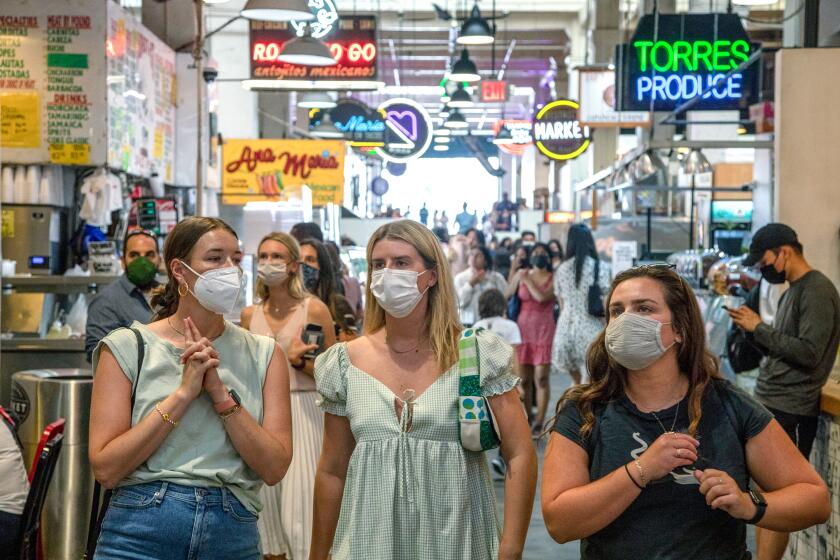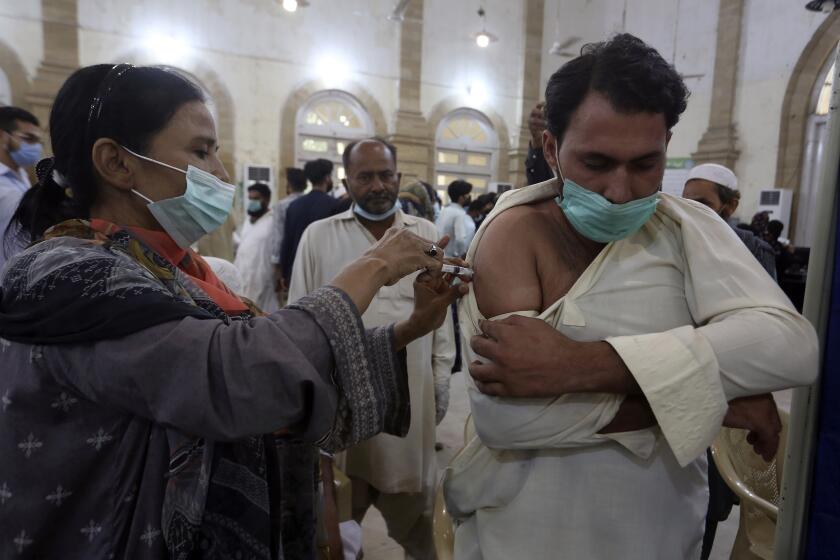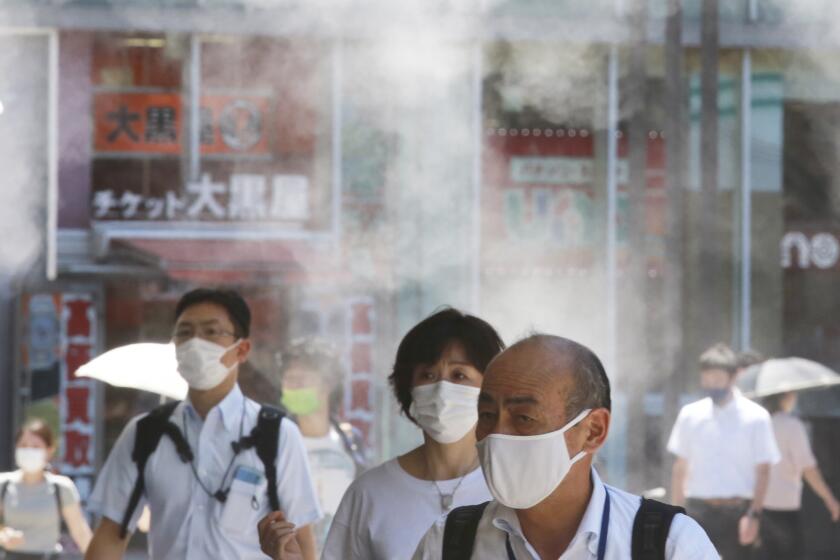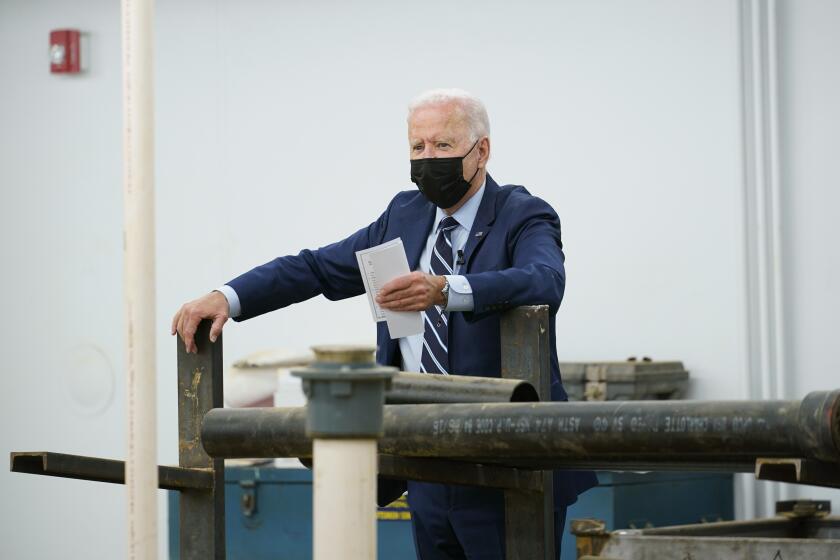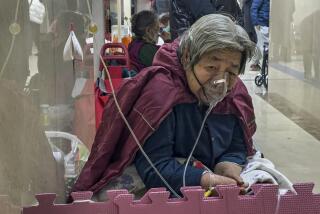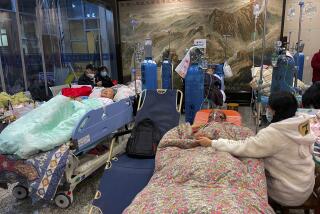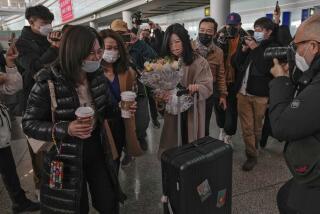Delta variant challenges China’s costly coronavirus lockdown strategy
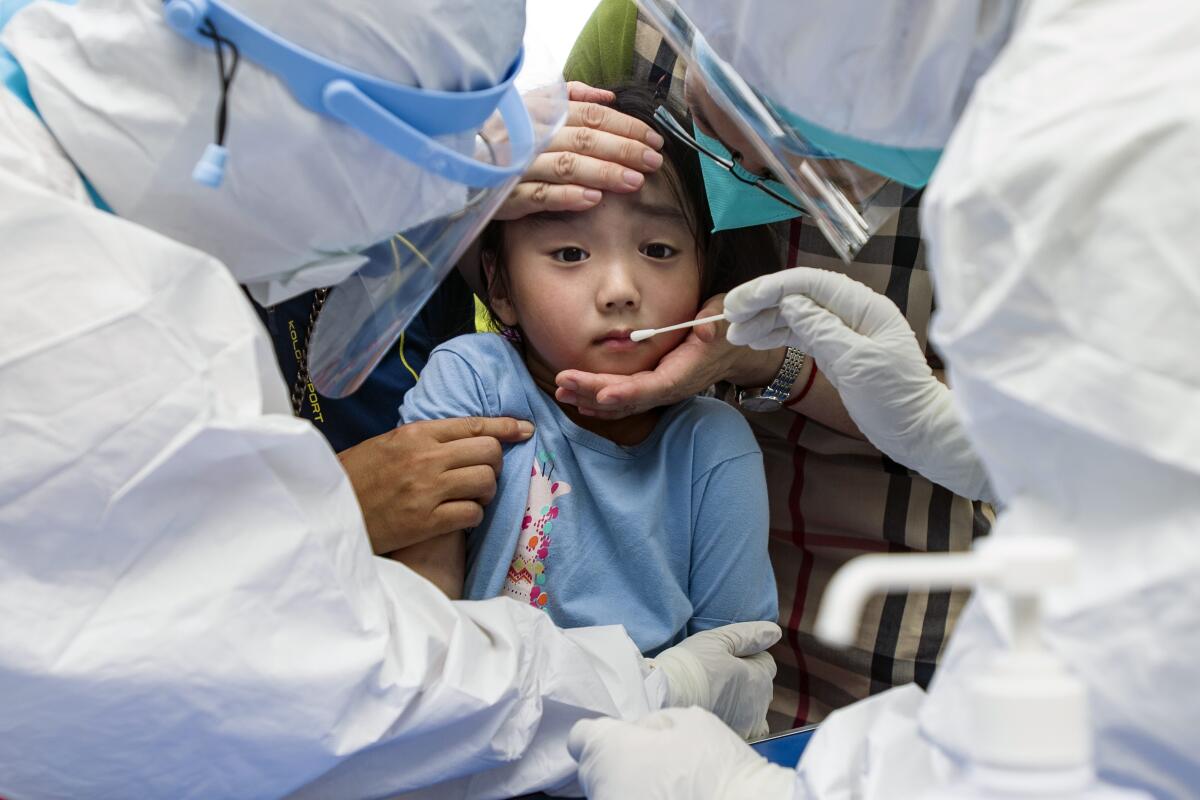
- Share via
BEIJING — The Delta variant is challenging China’s costly strategy of isolating cities, prompting warnings to Chinese leaders that a less disruptive approach is needed to try to keep the coronavirus out of the country.
As the highly contagious variant pushes leaders in the U.S., Australia and elsewhere to renew restrictions, Chinese President Xi Jinping’s government is fighting the most serious outbreak since last year’s peak in Wuhan. The ruling Communist Party is reviving measures that shut down China back then: Access to a city of 1.5 million people has been cut off, flights have been canceled and mass testing has been ordered in some areas.
That “zero tolerance” strategy of quarantining every case and trying to block new infections from abroad helped to contain last year’s outbreak and has kept China largely coronavirus-free since then. But its impact on work and life for millions of people is prompting complaints that China needs to learn to control the virus without repeatedly shutting down the economy and society.
Zhang Wenhong, a Shanghai doctor who became prominent during the Wuhan outbreak, suggested in a social media post that China’s strategy could change. “We will definitely learn more” from the ongoing outbreak, he said, calling it a stress test for the nation.
“The world needs to learn how to coexist with this virus,” wrote Zhang, who has 3 million followers on the widely used Sina Weibo platform.
China’s controls will be tested when thousands of athletes, reporters and others arrive for the Winter Olympics in Beijing in February. And the ruling party faces a politically sensitive change of leadership in late 2022, for which leaders want upbeat economic conditions.
The L.A. City Council will consider requiring that people show their vaccination status to visit indoor places such as restaurants, stores and gyms.
Last year, China shut down much of the world’s second-biggest economy and cut off almost all access to cities with a total of 60 million people — tactics imitated on a smaller scale by governments from Asia to the Americas. That caused China’s most painful economic contraction in five decades, but Beijing was able to allow business and domestic travel to resume in March 2020.
The new infections, many in people who have already been vaccinated, have jolted global financial markets, which worry that Beijing’s response might disrupt manufacturing and supply chains. The main stock indexes in Shanghai, Tokyo and Hong Kong sank Tuesday but were rising again Thursday.
China needs to shift to creating barriers to infection within communities by stepping up vaccinations and quickly treating infected people while allowing business and travel to go ahead, said Xi Chen, a health economist at the Yale School of Public Health. He said the country needed access to the full range of vaccines, including allowing use of the Pfizer-BioNTech shot.
“I don’t think ‘zero tolerance’ can be sustained,” said Chen. “Even if you can lock down all the regions in China, people might still die, and more might die due to hunger or loss of jobs.”
Booster moratorium, or booster momentum? WHO chief’s call to ease vaccine disparity draws mixed response
Beijing has so far shown no sign of changing course.
Disease controls must “be even faster, more firm, stricter, more expansive and ready,” He Qinghua, an official with the National Health Commission’s Disease Control Bureau, said at a news conference Saturday.
The year’s biggest outbreak has tentatively been traced to airport employees who cleaned a Russian airliner July 10 in Nanjing, northwest of Shanghai in Jiangsu province, according to health officials.
Some travelers flew through Nanjing to Zhangjiajie, a popular tourist spot southwest of Shanghai in Hunan province, turning that city into a center for the virus’ spread. The disease was carried to Beijing and other cities in more than 10 provinces.
Tokyo reported 5,042 new daily coronavirus cases, hitting a record as the infections surge in the Japanese capital hosting the Olympics.
On Tuesday, the government of Zhangjiajie announced that no one was allowed to leave the city, imitating controls imposed on Wuhan, where the first virus cases were identified, and other cities last year.
Flights to Nanjing and Yangzhou, a nearby city with 94 cases, were suspended. Trains from those cities and 21 others to Beijing were canceled. Jiangsu province set up highway checkpoints to test drivers. The government called on people in Beijing and the southern province of Guangdong not to leave those areas if possible.
In Yangzhou, children at two tutoring centers were quarantined after a classmate tested positive, according to Zhou Xiaoxiao, a university student there. She said some parts of the city were sealed.
Eggs and some other food items were scarce after shoppers cleaned out supermarkets in anticipation of a lockdown, Zhou said. She said the government was delivering rice to households.
The Biden administration is taking the first steps toward requiring nearly all foreign visitors to the U.S. to be vaccinated against COVID-19, a White House official says.
“The price of vegetables has risen. That’s nothing to me. But to the kind of family whose life isn’t very good and who have no income, it’s very troublesome,” said Zhou, 20.
The 1,142 infections reported since mid-July, many linked to Nanjing, are modest compared with the tens of thousands of new daily infections in India and the U.S. But they jolted leaders in China, which hasn’t recorded a COVID-19 fatality since early February.
The outbreak poses “serious challenges to the country’s hard-won victory in the epidemic battle,” said the newspaper Global Times, which is published by the ruling party’s People’s Daily.
China has reported 4,636 deaths out of about 93,000 confirmed cases.
So far, most of the people infected in Nanjing had been vaccinated, and few cases are severe, the head of the critical care unit at the hospital attached to the city’s Southeastern University, Yang Yi, told a Shanghai news outlet.
She said that means “vaccines are protective” — though concerns remain that Chinese-made vaccines offer less protection than some others.
Authorities have blamed Nanjing airport managers and local officials for failing to enforce safety rules or to detect infections for 10 days until July 20, after the coronavirus had spread.
A 64-year-old woman who is believed to have carried the virus from Nanjing to Yangzhou was arrested Tuesday on suspicion of hindering disease prevention, police announced.
Wisconsin officials say they’ve found about 500 coronavirus cases that could be linked to the crowds that gathered to support the Milwaukee Bucks.
Cleaning staff at Nanjing’s new international terminal mingled with co-workers in the domestic wing when they should have been separated, according to news reports. Because of bad weather, the Russian airliner was diverted to Nanjing from Shanghai, where airports are better-equipped to handle foreign travelers.
Still, Nanjing, a city of 9.3 million people, is the second-biggest in eastern China after Shanghai and has more resources than many smaller cities.
China needs to learn how to “allow the virus to exist” in areas with high vaccination rates and stronger healthcare, said Chen, the economist. He noted that some areas have vaccinated at least 80% of adults.
“I don’t think they are blind to this,” said Chen. “They should already be thinking about it.”
More to Read
Sign up for Essential California
The most important California stories and recommendations in your inbox every morning.
You may occasionally receive promotional content from the Los Angeles Times.
